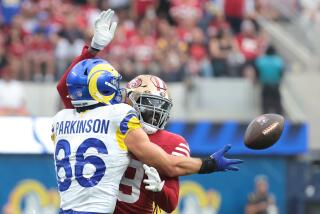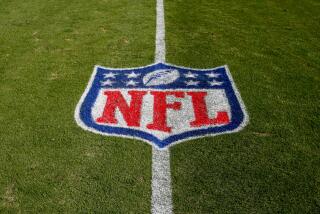Stopping 49er Offense Can Be a Killer : Dolphins Will Need All Their B’s, as Well as C’s for Creativity
- Share via
SAN FRANCISCO — Some of the National Football League’s most thoughtful coaches believe that the more creative of the two defensive teams will win Sunday’s Super Bowl game.
They reason that both offenses are so effective that conventional defenses can’t slow them down but that a particularly imaginative defensive plan might.
If the Miami Dolphins are considering one, especially for their Killer B’s in the secondary, it won’t surprise some people, including Ernie Stautner, the defensive coordinator of the Dallas Cowboys.
“The kind of thing to use against San Francisco is the nickel (defense) on first down,” Stautner said, referring to the use of five defensive backs on passing downs. “You’ve got to keep (quarterback) Joe Montana off balance--especially in the first quarter.”
In recent years, the 49ers have attacked their opponents in the first quarter with what coaches call a script offense. During the week before each game, 49er Coach Bill Walsh prepares a list of 15 or 20 new plays, which are then called in order, regardless of the circumstances.
That often bewilders defensive teams. Playing Montana to throw the ball on, say, second and 12, they find themselves chasing halfback Wendell Tyler instead because Walsh planned it that way nearly a week ago. He had expected second and one.
“In my opinion, the best way to meet Walsh’s script plays is with random defensive calls,” a veteran NFL offensive coordinator said. “Try six defensive backs on first down and come back with your regular first-down defense on second down--whether it’s second and 10 or second and whatever. If you guess wrong, of course, the 49ers have an easy touchdown.”
Contemplating the heresy of what he’d just said, the man added:
“But so what? If you play percentage (defensive) football in the first quarter, (Walsh) is going to score anyway. They’ve won every first quarter this year--for the same reason. The defenses are playing percentages and the 49ers aren’t. The right way to defense Montana in the first quarter is to play for interceptions. Use your wildest coverages and go for the ball.”
The speaker was one of 10 NFL coaches consulted on Super Bowl strategy. Included were assistants, coordinators and head coaches. Some asked that their names be withheld.
One head coach, disagreeing with Stautner, said: “I’d be as sound as possible on every play against that team. “Concentrate, be alert, be smart.”
He and the other coaches were in agreement on most other key matters of strategy, including what they called the important point.
As San Diego defensive coordinator Tom Bass said: “When you play San Francisco, you need two game plans--one for their script offense and another for the second half.”
Two are necessary because of Walsh’s motive in beginning with 15 or 20 pre-called plays. He hopes to discover defensive tendencies in all kinds of down-and-distance situations--making the rest of the game a piece of cake.
Said a defensive coordinator: “The hardest thing to do in a 49er game is to stop them in the first quarter without showing too much of the basic defensive game plan you’ve worked out for the whole game.”
It is, in other words, a tricky business, defending against Montana. He is the NFL’s most dangerous running passer. He also has the assistance of useful tools: Tyler and Roger Craig in the backfield, Freddie Solomon and Dwight Clark at wide receiver, and sprinter Renaldo Nehemiah and tight end Russ Francis for deeper throws.
What is the NFL’s conventional defensive approach against the 49ers?
“Everybody tries to do two things,” said Chet Franklin, defensive backfield coach of the Raiders. “They want to contain Montana on rollouts. And they want to get quick coverage on his receivers.”
Miami’s personnel isn’t particularly well suited for either role. Consider:
--Containing Montana requires a straight-ahead charge, rather than an angling charge directly at him. That will only delay Miami’s best rusher, defensive end Doug Betters.
On his most successful days, Betters nails the passer himself. But against the 49ers, the most valuable contribution of a defensive end isn’t necessarily a sack but to make Montana step forward in the pocket, where his short stature--he is reportedly under 6 feet 1 inch--puts him at a disadvantage.
--In Miami’s customary zone defenses, the cornerbacks line up several yards away from the other team’s wide receivers. That isn’t the best way to get close coverage on Clark and Solomon.
The defensive players who have been most successful against the 49ers are those who can rough up Montana’s receivers and deal a blow to the rhythm of San Francisco’s offense.
Most of Montana’s passes are closely timed, meaning that he throws to, say, Clark, on a count of 2, or 3 1/2 or 4. But Clark can’t get to his appointed place on time if a defensive back bumps him around for three or four seconds.
Unhappily for the Dolphins, bumping isn’t their style. They will have to think of something else. Their friends believe a really creative defensive approach could do it.
“Imaginative football isn’t inconsistent with what they do best,” an offensive coordinator said. “(Coach Don) Shula uses some of the most complicated zone defenses in the league. All he has to do is get more complicated--a lot more. He has to gamble that he can get some first-quarter interceptions.”
In any case, gambling is the modern trend in defensive football. The Chicago Bears and Pittsburgh Steelers, reached the conference finals this season by gambling with frequent blitzes. The Dolphins, who probably can’t blitz Montana, regardless, would be gambling with strange coverages.
“It’s their best chance,” the man said.”
More to Read
Go beyond the scoreboard
Get the latest on L.A.'s teams in the daily Sports Report newsletter.
You may occasionally receive promotional content from the Los Angeles Times.










